Latebreaking Submissions Due

Take Action for Science
We stand for science, so we are deeply concerned about potential federal cuts to scientific funding that would have devastating effects. Contact Congress today!
Read more
Funding Still Available
Looking for funding for #ESA2025? We are accepting applications for registration and dependent care grants from ESA, and many sections and chapters have open opportunities, too.
Read more
Our 2025 Fellows
ESA's fellowship program recognizes the many ways in which our members contribute to ecological research, communication, education, management & policy.
Read moreJournals & Publications
-
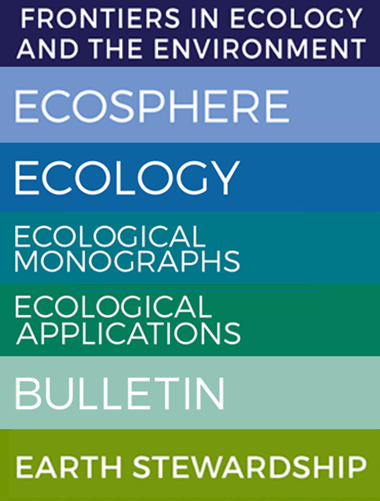
The Ecological Society of America has over 100 years of journal publishing history and offers some of the most widely read and cited journals in the field of ecology. The seven journals in our portfolio encompass a wide range of paper types to include an array of aims and scope of study, making them an important and accessible outlet for scientists, researchers, practitioners, professionals, citizen scientists, and others seeking to publish their work. ESA staff provide editorial support with our publishing partner, John Wiley & Sons, and several discounts towards publication in ESA journals are available from our publisher and from ESA. Publishing in ESA journals contributes to ESA programs for students, early career researchers, and underrepresented groups, and we thank our editors, reviewers, authors, and readers for their support.
-
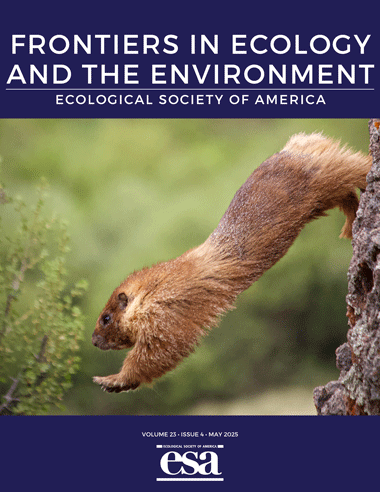
Predicting range shifts under climate change remains challenging for conservation planning, as traditional models require extensive data and struggle to capture localized shifts. A new study by Billman et al., published in the May issue of Frontiers, suggests that simple abundance patterns may serve as early warning signs for these shifts. By analyzing 71 montane species, including birds, insects, mammals, reptiles, and plants, the authors found that populations with strongly skewed abundance distributions in historical surveys tended to shift their lower range limits in the same direction over time. This cost-effective approach helps identify at-risk populations and inform management strategies before shifts materialize, and should apply across other range-shifting taxa like the yellow-bellied marmot (Marmota flaviventris) shown on the May 2025 cover.
-
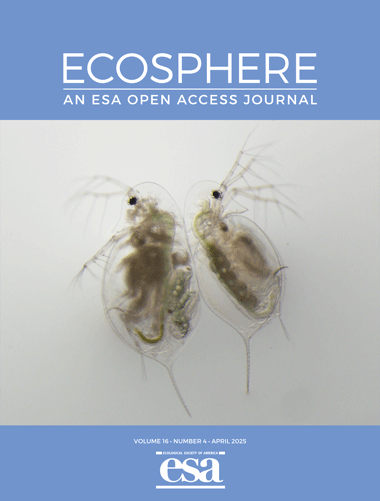
In nature, organisms face variable resource environments as well as attack by a variety of parasites. The impact of changing resources on host-parasite interactions can be difficult to intuit, but experiments can help uncover patterns and underlying mechanisms. Fearon et al. conducted a study—published in the March issue of Ecosphere—on the ecologically important zooplankter Daphnia and found that diets that contained the cyanobacterium Microcystis strongly protected against attack by a fungal parasite. Pictured on the April cover of Ecosphere, the individual on the left fed on green algae and became infected by the fungus, whereas the individual who fed on Microcystis (right) remained healthy. In contrast, the presence of Microcystis in the diet did not influence whether hosts became infected with a bacterial parasite, but did influence the fitness of infected hosts. These results suggest the potential for eutrophication (and the associated increases in Microcystis blooms) to alter the relative abundances of parasites, as well as to alter the fitness impacts of infection.
-
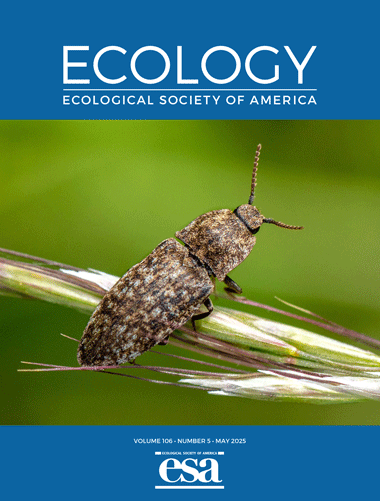
The May cover of Ecology shows an adult click beetle, Agrypnus murinus, a species common in grasslands of the northern hemisphere, sitting on a blade of grass. The photo was taken in May 2022 at the Jena Experiment field site, a long-term grassland biodiversity experiment. This beetle is one of many arthropods featured by Bröcher et al. in their data paper in the April issue of Ecology which compiles trait data for over 1,300 species, including coleopterans, arachnids, hemipterans, hymenopterans, isopods, myriapods, and orthopterans. The traits span feeding ecology, habitat requirements, flight capability, and size, offering a comprehensive resource for exploring arthropod functional roles in grassland ecosystems.
-
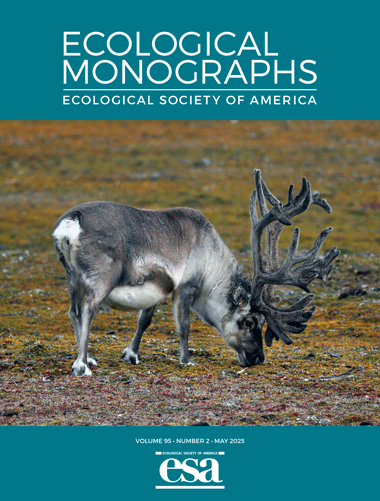
Changes in animal migration behavior are increasingly documented in response to rapid global change. The Svalbard reindeer (Rangifer tarandus platyrhynchus) is a partially migratory ungulate with studies reporting a decline in the proportion of migrants between 1998 and 2008. Inspired by empirical evidence from multiple partially migratory species, Liu et al. developed a theoretical model that highlights the key role of seasonal density dependence in shaping migratory propensity at population level. Their study is published in the February issue of Ecological Monographs. The May cover image shows a Svalbard reindeer foraging in Ny-Ålesund, Svalbard, Norway, photographed in August 2019.
-
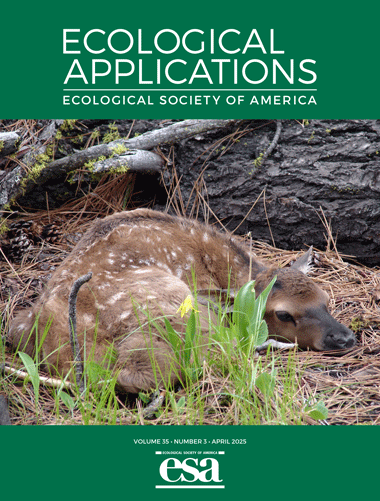
Pregnancy rates of large herbivores like North American elk (Cervus canadensis) are nutritionally mediated and can influence population performance. In their paper published in the March issue of Ecological Applications, Robatcek et al. developed a series of linked models for predicting variation in pregnancy rates among populations of elk as a function of foodscape use and availability. The study finds that pregnancy was influenced more strongly by foodscape heterogeneity than by absolute differences in forage availability among populations. The April issue's cover photograph features an elk calf, <24 hours old, hiding to avoid detection.
-
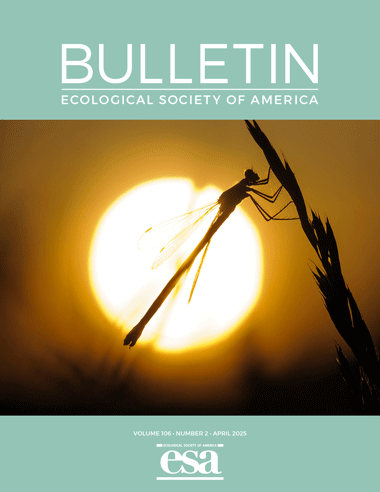
The April issue of the ESA Bulletin continues its focus on ecology education and communicating science with articles that highlight the benefits of a diverse ecology education, collaboration between students, educators, and scientists, and tips to increase a research team's productivity and effectiveness. As the record for society business, the April issue also includes reports of society actions, Resolutions of Respect, and an extensive Photo Gallery highlighting research published in the ESA journal portfolio.
-
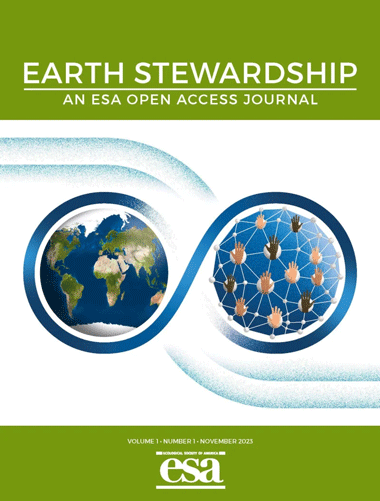
We are delighted to announce a call for submissions for Earth Stewardship. This exciting new Open Access journal, launched with our publishing partner, John Wiley & Sons, calls for a broad spectrum of scientifically and technologically innovative and groundbreaking contributions including cross-cultural perspectives from leading researchers, policymakers, traditional custodians of land and sea and indigenous communities. Earth Stewardship publishes applied and theoretical articles to promote a broad, intercultural, and participatory foundation for earth stewardship.
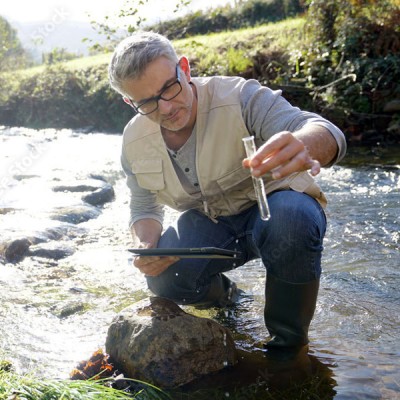
Professional Certification
Employers in all sectors value a credential that validates your skill as a professional. Learn more about ongoing changes to ESA certification and start your application today!
Read more
Opportunity Fund Donations
Make a difference and fund programs which empower, educate and embolden both the current and next generation of scientists in the vast field of ecology.
Read more
Next Year's Annual Meeting
The 2025 Annual Meeting will be held in Baltimore, Maryland. Select the following link and check out the theme, preliminary schedule, exhibitor opportunities and upcoming deadlines for proposals.
Read more